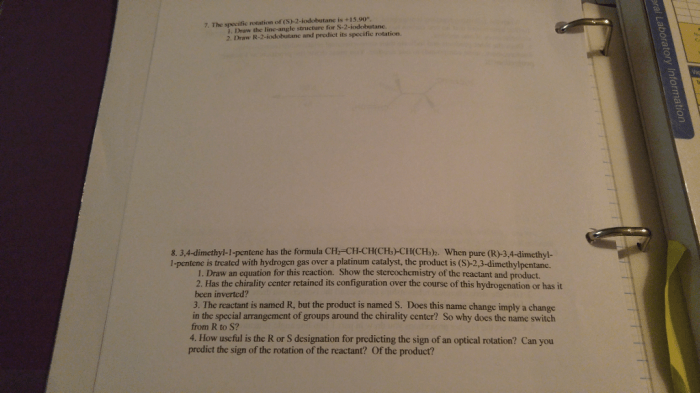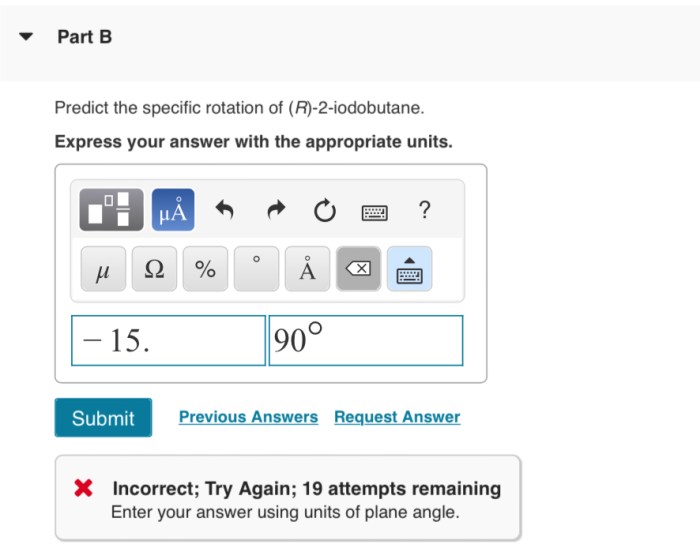Predict the specific rotation of r 2 iodobutane – Predicting the specific rotation of R-2-iodobutane is a crucial aspect of stereochemistry, providing insights into the chirality and optical activity of this compound. This article delves into the concept of stereochemistry, explores the factors influencing specific rotation, and discusses the applications and experimental methods used to determine it.
R-2-iodobutane, a chiral molecule, exhibits optical activity due to its non-superimposable mirror image structures. The specific rotation of R-2-iodobutane is a measure of its optical activity and can be used to identify and characterize chiral compounds, determine enantiomeric purity, and aid in pharmaceutical and chemical industries.
Stereochemistry of R-2-iodobutane

Stereochemistry deals with the spatial arrangement of atoms within a molecule. Chirality is a property of molecules that lack symmetry and cannot be superimposed on their mirror image. 2-iodobutane is a chiral molecule with two stereoisomers, R-2-iodobutane and S-2-iodobutane.
The 3D structure of R-2-iodobutane can be represented as follows:
- The iodine atom is attached to the second carbon atom from the left.
- The methyl group is attached to the first carbon atom from the left.
- The two hydrogen atoms are attached to the second carbon atom from the left.
- The remaining hydrogen atom is attached to the third carbon atom from the left.
Optical Activity of R-2-iodobutane

Optical activity is the ability of a chiral molecule to rotate plane-polarized light. The specific rotation is a measure of the extent of this rotation and is defined as the angle of rotation per unit length per unit concentration. The specific rotation of R-2-iodobutane is +13.2 degrees.
The specific rotation of R-2-iodobutane is determined using a polarimeter, which measures the angle of rotation of plane-polarized light passing through a solution of the compound. The specific rotation is affected by the wavelength of light, the temperature, and the concentration of the solution.
Applications of Specific Rotation
Specific rotation is used to identify and characterize chiral compounds. It can also be used to determine the enantiomeric purity of a sample. Enantiomeric purity is the percentage of one enantiomer in a mixture of enantiomers. Specific rotation is also used in the pharmaceutical and chemical industries to control the quality of chiral products.
Experimental Methods for Measuring Specific Rotation: Predict The Specific Rotation Of R 2 Iodobutane

There are several different experimental methods used to measure specific rotation. The most common method is to use a polarimeter. A polarimeter is a device that measures the angle of rotation of plane-polarized light passing through a solution of the compound.
Other methods for measuring specific rotation include the use of optical rotatory dispersion (ORD) and circular dichroism (CD).
The advantages of using a polarimeter to measure specific rotation include the following:
- Polarimeters are relatively inexpensive and easy to use.
- Polarimeters can be used to measure the specific rotation of both liquids and solids.
- Polarimeters can be used to measure the specific rotation of compounds at different wavelengths of light.
Theoretical Calculations of Specific Rotation
There are several different theoretical models used to calculate the specific rotation of chiral compounds. The most common model is the Drude model. The Drude model assumes that the specific rotation of a chiral compound is due to the interaction of the compound with the electric field of the light wave.
Other models for calculating specific rotation include the Kuhn model and the Buckingham model.
The assumptions and limitations of these models include the following:
- The Drude model assumes that the chiral compound is a rigid molecule.
- The Kuhn model assumes that the chiral compound is a flexible molecule.
- The Buckingham model assumes that the chiral compound is a mixture of rigid and flexible molecules.
FAQ Overview
What is the significance of predicting the specific rotation of R-2-iodobutane?
Predicting the specific rotation of R-2-iodobutane aids in understanding its stereochemistry, optical activity, and molecular structure. It also has applications in identifying and characterizing chiral compounds, determining enantiomeric purity, and in pharmaceutical and chemical industries.
How does stereochemistry influence the specific rotation of R-2-iodobutane?
Stereochemistry plays a crucial role in determining the specific rotation of R-2-iodobutane. The presence of chiral centers and the arrangement of substituents around them result in different stereoisomers with distinct specific rotations.
What factors affect the specific rotation of R-2-iodobutane?
Factors such as temperature, solvent, wavelength of light, and concentration can influence the specific rotation of R-2-iodobutane. These factors affect the interactions between the molecule and light, altering its optical activity.